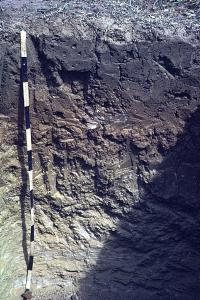Reference soil Kenya 14: Phaeozem
Phaeozems occur all over the world, but especially on the more moist side of the steppe regions, bordering Chernozems.
Characteristics
Soils having a mollic horizon (deep, brownish or blackish surface horizon with a significant accumulation of organic matter and high base saturation); a base saturation of 50 percent or more between 25 and 100 cm from the soil surface; a calcium carbonate-free soil matrix at least to a depth of 100 cm from the soil surface, or to a contrasting layer between 25 and 100 cm; no diagnostic horizons other than an albic, argic, cambic or vertic horizon, or a petrocalcic horizon in the substratum.
Reference soil KE014: Phaeozems
A strongly calcareous, moderately well drained soil derived from fine-grained sandstones, with common moderate clay cutans below 30 cm and a weak surface sealing (5 mm); inactive termite mounds (5-10 m diameter, 1-2 m height) appear. (R3 pg 215)
